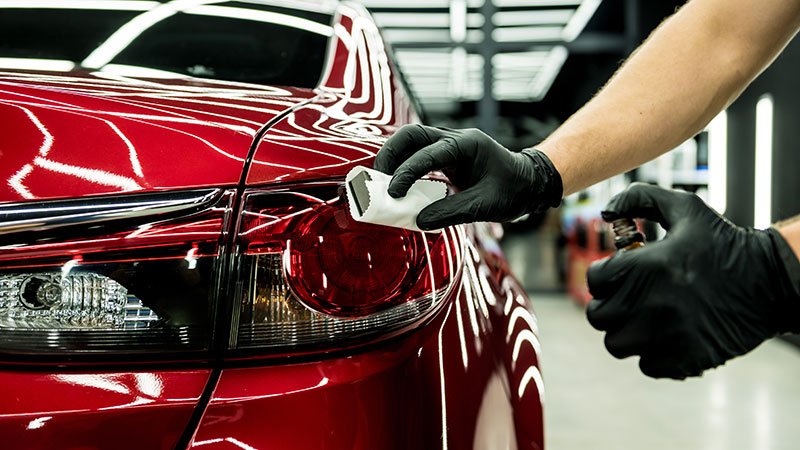Comprehensive Vehicle Care Solutions Supplied by Ceramic Coating Philadelphia Professionals
Comprehensive Vehicle Care Solutions Supplied by Ceramic Coating Philadelphia Professionals
Blog Article
Why Ceramic Layer Is the Ultimate Option for a Flawless End Up
Ceramic finish has actually arised as a leading option for those looking for a flawless coating for their cars, thanks to its exceptional longevity and protective features. What aspects truly established ceramic finish apart?
What Is Ceramic Finish?

When applied appropriately, ceramic covering creates a hydrophobic surface that fends off water and dust, making it much easier to cleanse and preserve. Unlike standard waxes or sealers, which usually provide short-term defense, ceramic finishes can last for several years, depending on the item quality and application method. The procedure of using ceramic coating needs careful prep work, consisting of comprehensive cleaning and in some cases repaint correction, to guarantee optimal bonding and efficiency.
Ceramic finishes are not limited to auto surfaces; they can additionally be made use of on various products, consisting of glass, metal, and plastics, providing a flexible service for enhancing defense. On the whole, ceramic finishing stands for a considerable development in surface area defense modern technology, combining both useful and aesthetic advantages for a large range of applications.
Advantages of Ceramic Layer
While numerous surface defense choices exist, the benefits of ceramic finishing stand apart due to its distinct residential or commercial properties and durable performance. One of the primary benefits is its remarkable durability. Ceramic Coating Philadelphia. Unlike typical wax or sealers that call for frequent reapplication, ceramic finishes supply a resilient layer that can last for several years, considerably reducing upkeep efforts
An additional significant advantage is enhanced protection versus ecological contaminants. Ceramic layers create a hydrophobic surface that drives away water, dust, and numerous pollutants, making it much easier to clean up. This feature not only maintains the car's look but also minimizes the threat of deterioration and oxidation, especially in extreme climate condition.
Moreover, ceramic coverings offer exceptional resistance to UV rays, stopping fading and degradation of paint in time. This UV protection is vital for keeping the visual value of surface areas and automobiles exposed to direct sunlight.
Additionally, the shiny finish achieved with ceramic covering improves the general visual allure, offering surfaces a showroom-quality shine. In general, ceramic layers represent a substantial improvement in surface defense innovation, giving long-lasting advantages that accommodate both functional and visual demands.
Exactly How It Works
Recognizing the science behind ceramic coatings discloses exactly how they provide such amazing defense and long life. At its core, a ceramic finishing is a fluid polymer that chemically bonds with the vehicle's factory paint.
The application process entails several actions, consisting of surface preparation, which is important to attaining ideal bond. Once used, the covering undertakes a healing process, during which it hardens and creates a semi-permanent bond with the paint surface area. This bond is what distinguishes ceramic finishings from traditional waxes and sealers, offering a longer-lasting protective obstacle that can withstand for many years.
Moreover, the density of the layer can enhance its protective top qualities, guaranteeing that it can withstand extreme problems. Ultimately, the science of ceramic coatings incorporates innovative products with cutting-edge application techniques to deliver an unequaled level of protection and aesthetic improvement for automobiles.
Contrast With Traditional Approaches
The benefits of ceramic finishes end up being particularly obvious when contrasted to traditional paint protection methods such as sealants and waxes. While waxes use a temporary luster, generally lasting a couple of weeks to a pair of months, ceramic finishes offer a lasting protective layer that can sustain for numerous years. This longevity significantly lowers the frequency of reapplication, making ceramic finishes an extra economical solution in time.
Furthermore, traditional techniques commonly require extensive preparation and several applications to achieve a sufficient degree of protection. On the other hand, ceramic layers bond at a molecular level with the vehicle's surface, developing a robust guard versus ecological pollutants like UV rays, acid rain, and roadway salts. This bond improves the lorry's resistance to scrapes and swirl marks, which prevail with typical waxes and sealants.
Moreover, the hydrophobic homes of ceramic coverings repel water and dirt, leading to less complicated cleaning and maintenance. In comparison, wax and sealant-treated surface areas can draw in gunk, necessitating more regular washing - Ceramic Coating Philadelphia. On the whole, ceramic coatings not just supply exceptional security however also supply a more enduring and aesthetically enticing coating, establishing them as the hop over to these guys preferred choice for critical automobile proprietors
Application and Upkeep Tips

Making use of a foam applicator, apply the covering in little sections, complying with the maker's guidelines pertaining to thickness and overlap. Allow sufficient healing time in between layers, commonly 24 hr, to guarantee correct bonding. After application, it is crucial to prevent exposure to water or extreme components for at the very least a week to permit the covering to totally cure.
Furthermore, making use of a ceramic maintenance spray can improve the finishing's that site hydrophobic homes and longevity. Regular examinations for any indicators of wear will certainly aid keep the finish's honesty and maintain that beautiful surface.
Final Thought
In verdict, ceramic finish becomes a premium choice for achieving a remarkable automotive surface. Its extraordinary toughness, safety qualities, and hydrophobic properties significantly boost the vehicle's look while simplifying upkeep efforts. By forming a durable bond with manufacturing facility paint, ceramic finish properly shields against scratches, UV rays, and environmental contaminants. With a life expectancy prolonging several years, this innovative remedy not just protects but likewise elevates the total visual charm of vehicles, making it an affordable financial investment for vehicle enthusiasts.

Report this page